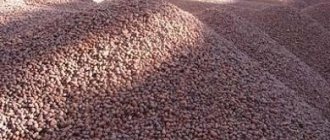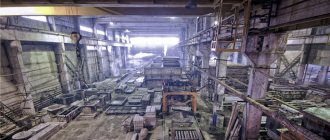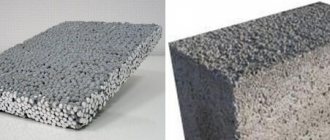Construction volumes in Russia are constantly growing, so entrepreneurs are willing to invest in the production of building materials. One of the profitable niches is concrete production. This business requires large investments, but also promises good profits. It is impossible to achieve success in such a large-scale undertaking if a well-thought-out business plan for a concrete production plant with calculations is not drawn up. It will help determine the effectiveness of the project and quickly return and increase the invested funds.
What is a concrete production business?
Modern realities are such that a business based on the production and sale of concrete is among the most profitable ways of making a profit.
Given the dynamics of the construction industry (especially in large cities with large populations), the demand for this material continues to grow. The demand for this building material will always remain high. And its largest buyer is companies specializing in the construction industry. If you are interested in investing in this area, then the most correct decision to purchase a mini concrete plant would be at the very beginning of the construction intensification season. As a rule, such a period is the month of May. This must be done because by the end of the season (that is, by November), you will be able to start promoting your business and make a good profit.
Purchase of equipment
Equipment for the technological process for the production of concrete building mixtures is an automated installation. Value for money is offered by Chinese manufacturers, who additionally provide installation, commissioning of equipment and personnel training. Russian equipment is more expensive, but cheaper to repair and components.
The standard equipment of an automated concrete plant line includes:
- cement silo for 60 tons;
- dispensers for aggregates, for cement and water;
- mixer for exposed concrete;
- mixer for basic concrete;
- belt conveyor and exit return conveyor;
- screw;
- reducer;
- lift;
- rail loader;
- plate conveyor;
- control panel cabin.
Studying the competitive environment between mini-factories
Before moving forward, it is worth drawing up a business plan for the development of a concrete production plant. You need to understand with whom and how you have to compete, and decide on a pricing policy. The main target consumer is developers, they will absorb up to 90-95% of your production volume (these figures are obtained based on market analysis data). The difference in the coefficient between the growth rate of the construction sector and the production of concrete is 0.9 units.
However, it is necessary to understand that a mini concrete production plant has certain specifics, in the form of geographic localization on the ground. The technology is such that it is possible to sell concrete profitably only within a radius of up to 50 kilometers from the location of the plant. Therefore, first of all, you have to assess the level of competition in the area where production development is planned. The current practice gives a real understanding that it will not be possible to win in the competition with the help of dumping in the price level of products alone.
Having studied the issue, you should understand that the vast majority of factories produce approximately the same brand of concrete mixtures and their characteristics are almost the same. Production and manufacturing technologies are well known, and anyone can master them. The company's sales volume depends only on how great the demand is in the area where your plant is located.
Serious competition can come from entrepreneurs engaged in the production and sale of construction products, using which the need to use concrete can be avoided. Problems will arise if, not far from your concrete production plant, there is an enterprise whose specialization is concentrated in the production of building structures and reinforced concrete profiles.
The ticket to the future, in which you can make systematic profits and grow your company, will be agreements with target consumers. It is important that these transactions have a long-term basis. Only in this way will you have the strength to withstand the competition.
Reviews from our clients
Feedback on the business plan for a concrete plant
We were satisfied with the business plan for a concrete plant. All formulas are easy to use and very simple, all explanations are clear, and any changes can be made to the finished model. In fact, this is the first business plan that has proven to be easy to use and clear to understand.
M. L. Ivanova, Financial Director, World of Construction JSC
Feedback on the business plan for the production of paving slabs
The purpose of planning was, on the one hand, to attract funding, and on the other hand, we also wanted to have a clear picture of how we would develop. In the end, I liked the plan. In the business plan for a workshop for the production of paving slabs, I liked the financial model, I liked that it was easy to use, easy to adjust to your needs, and there were no questions about it in the bank either. At the moment, a loan of 19 million rubles has been received. Thank you! This result was obtained, including with your help. Good luck!
Maksimov K.O., Nizhny Novgorod,
Feedback on the business plan for developing a sand quarry for sand extraction
To expand production, we needed to attract investors. More precisely, we had “our own” investor, but in order to work with him we needed a business plan. Representatives of the company plan-pro.ru provided us with invaluable assistance in drawing up this document, as a result of which the investor was satisfied with the quality of the business plan. We received investments worth 40 million rubles for the purchase of new equipment.
Egor Valerievich, Kostroma, General Director
Registering a business and choosing a tax system
In the business plan being developed, it is imperative to include the issue of registering a legal entity, in our case it will be a Limited Liability Company (LLC). This step is important for several reasons. The first is that in case of any unforeseen situations, the LLC is responsible only with its authorized capital. Secondly, any company or organization will agree to work with an organization of a similar form of ownership.
To organize and conduct the production in question, the OKVED code is determined: 26.63. The production of ready-mixed concrete requires the following standards (they must comply with established GOSTs):
- “Concrete. Methods for determining frost resistance" (10060.0-95);
- “Concrete. Squad selection rules" (27006-86);
- “Concrete. Rules for controlling compressive strength for monolithic structures" (18105 – 86).
- “Concrete mixtures. Test methods" (10181-2000);
- “The concrete is heavy and fine-grained. Technical conditions" (26633-91);
Let's move on to choosing a taxation system; in generally accepted practice, this is the general taxation system, the simplified tax system for annual revenues of less than 60 million rubles. To maintain accounting records for an enterprise, it is necessary to hire an accountant. The taxation system of the enterprise under consideration is the simplified tax system “income-expenses” 7%.
Characteristic features of mini production
The sale of concrete mixtures is accompanied by a characteristic problem - solving difficulties with organizing the delivery of products to their destination. Concrete has certain properties that require it to be transported to its destination at a strictly defined time. If you linger longer than the technology allows, the composition may harden. The composition is delivered to the construction site in specialized vehicles called “concrete mixers.”
An alternative option is to produce finished molds on site. After hardening, these forms are transported to the building site. But the most advantageous option is production right on the construction site. This is precisely the reason that requires some geographical localization of production.
Raw materials used for production
Modern technology for the production of concrete solutions requires the following components:
- One of the main components of mixtures is water. It must be of high quality and clean, and not contain foreign matter. The volume of its supply is determined by the technologist.
- Ballast mixture, also called general mixture. This is a kind of porridge of sand and gravel. The most suitable proportion of components is three parts gravel to one part sand;
- Crushed stone - crushed gravel is used as this component (the most suitable, extracted from rocks), its standard diameter is about 5 mm. Addition of slags is allowed.
- Sand. It must meet the requirements of GOST 8736-93, where the diameter of sand grains is no more than half a millimeter.
- Cement. The main component of the mixture. This is a loose powder mass of a grayish tint. During the production process of the mixture, the powder crystallizes after adding liquid.
Depending on the required brand of concrete, the proportions between the main components differ. For example, to produce grade 100 concrete we need 1 kg. cement grade 400, 4.1 kg. sand, 6.1 kg. crushed stone and water
| Concrete grade | proportions cement: sand: crushed stone | |
| cement grade 400 | cement grade 500 | |
| 100 | 1,0 : 4,1 : 6,1 | 1,0 : 5,3 : 7,1 |
| 150 | 1,0 : 3,2 : 5,0 | 1,0 : 4,0 : 5,8 |
| 200 | 1,0 : 2,5 : 4,2 | 1,0 : 3,2 : 4,9 |
| 250 | 1,0 : 1,9 : 3,4 | 1,0 : 2,4 : 3,9 |
| 300 | 1,0 : 1,7 : 3,2 | 1,0 : 2,2 : 3,7 |
| 400 | 1,0 : 1,1 : 2,4 | 1,0 : 1,4 : 2,8 |
| 450 | 1,0 : 1,0 : 2,2 | 1,0 : 1,2 : 2,5 |
We will also give the consumption of materials per cubic meter of concrete.
| Concrete grade | Cement brand | Water-cement ratio | Filler grain size, mm | Water volume, l/m3 concrete | Cement weight kg/m3 concrete | Sand weight kg/m3 concrete | Weight of crushed stone/gravel, kg/m3 of concrete |
| M100 | M300 | 0,75 | Gravel 10 | 205 | 273 | 1092 | 1092 |
| 0,8 | Crushed stone 10 | 205 | 275 | 1100 | 1100 | ||
| 0,75 | Graphy 20 | 220 | 253 | 1012 | 1012 | ||
| 0,8 | Crushed stone 20 | 190 | 256 | 1024 | 1024 | ||
| M200 | M400 | 0,63 | Gravel 10 | 205 | 325 | 1300 | 1300 |
| 0,68 | Crushed stone 10 | 220 | 324 | 1296 | 1296 | ||
| 0,63 | Gravel 20 | 190 | 302 | 1208 | 1208 | ||
| 0,68 | Crushed stone 20 | 205 | 302 | 1208 | 1208 | ||
| M250 | M500 | 0,64 | Gravel 10 | 205 | 320 | 1280 | 1280 |
| 0,69 | Crushed stone 10 | 220 | 319 | 1276 | 1276 | ||
| 0,64 | Gravel 20 | 190 | 297 | 1188 | 1188 | ||
| 0,69 | Crushed stone 20 | 205 | 297 | 1188 | 1188 |
How it works
- Install the equipment on a slight slope, this will make it more convenient to unload the mixture.
- Load all the components of the future solution into the mixer, while the factory recipe instructions must be strictly followed. This refers to order and proportions.
- Pour in water and turn on the mixer, stirring everything until smooth.
Tip: experts recommend not to overload the mixer. You must remember that approximately 30-40% of the volume will be filled with foam.
When mixing, it is necessary to activate the foam generator, which a little later it will begin to add to the “common boiler”. Wait approximately 7-10 minutes until the unit mixes all ingredients to the desired consistency. After this, the solution can be unloaded into formwork and molds, the price of which will be an order of magnitude lower than the purchase price.
Staff
For smooth production and business operations at the plant, the following minimum number of workers is required.
| Job title | Qty | Salary | Salary | Total | |
| Human | rub/month | rub/shift | Payroll | ||
| RBU operator | 1 | 30000 | 1363,6364 | 30000 | |
| Loader driver | 1 | 30000 | 1363,6364 | 30000 | |
| Repairman | 1 | 30000 | 1363,6364 | 30000 | |
| Dispatcher | 1 | 20000 | 909,09091 | 20000 | |
| Technologist | 1 | 10000 | 454,54545 | 10000 | |
| Director of operations | 1 | 40000 | 1818,1818 | 40000 | |
| Director | 1 | 20000 | 666,66667 | 20000 | |
| TOTAL | 7 | 180000 | 7272,7273 | 180000 | |
Let's make a table showing the costs of the wage fund.
| Total | Total | Total | |
| 1 year | 2 year | 3 year | |
| RBU operator | 210000 | 210000 | 210000 |
| Loader driver | 210000 | 210000 | 210000 |
| Repairman | 210000 | 210000 | 210000 |
| Dispatcher | 140000 | 140000 | 140000 |
| Technologist | 70000 | 70000 | 70000 |
| Director of operations | 280000 | 280000 | 280000 |
| Director | 220000 | 240000 | 240000 |
| TOTAL PAYROLL | 1340000 | 1360000 | 1360000 |
And on payroll taxes.
| Total | Total | Total | |
| 1 year | 2 year | 3 year | |
| RBU operator | 63000 | 63000 | 63000 |
| Loader driver | 63000 | 63000 | 63000 |
| Repairman | 63000 | 63000 | 63000 |
| Dispatcher | 42000 | 42000 | 42000 |
| Technologist | 21000 | 21000 | 21000 |
| Director of operations | 84000 | 84000 | 84000 |
| Director | 66000 | 72000 | 72000 |
| TOTAL PAYROLL | 402000 | 408000 | 408000 |
It was decided to engage an accounting company under a contract for accounting services.
The amount of financial costs for the purchase of raw materials for concrete
The most popular brand of concrete, the safest to start working with, is the M 250 and M 350 grades.
Cost calculation depends on the selected production technology. In our business plan, we made a calculation based on the M 250 grade, so based on the consumption of materials per 1 m3 of ready-made concrete, the following figures will be obtained:
- M 250: crushed stone – 1280 kg, cement – 320 kg, sand – 1280 kg, water – 205 liters
Materials are purchased from officially operating quarries in the city of Yekaterinburg and nearby cities that have the necessary certificates and strength test reports for their material, etc., the cost of the material includes delivery to our territory
The volume of material consumption per 1 m3 of the finished product will be 2000 rubles, water costs will be included in utility costs, because We do not purchase water, but get it from a well.
There are other associated costs - staff salaries, costs for work clothes and equipment for work, diesel fuel for the loader, payment for electricity and site rental. If all this is taken into account, then the production cost will increase to 2,250 rubles per 1 m3 of finished concrete. The next section of the business plan provides a detailed table of variable and fixed costs.
Company personnel policy
The concrete production staff consists of the following job groups:
Administration: accountant, director. Opening hours: from 09:00 to 19:00 from Monday to Friday. Saturday and Sunday are days off.
Driver, sales manager, loader, production line foreman, security guard. Shift work every other day.
More details about the staff and its costs are in the table:
| Employee's position | Units per state | Amount of remuneration, rub. | Total, rub. |
| Director | 1 | 40 000 | 40 000 |
| Accountant | 1 | 30 000 | 30 000 |
| Foreman on a production line | 2 | 25 000 | 50 000 |
| Sales manager | 2 | 20 000 | 40 000 |
| Driver | 2 | 35 000 | 70 000 |
| Loader | 2 | 10 000 | 20 000 |
| Total | 10 | 250 000 |
To the total amount we add contributions to various state funds in the amount of 65,000 rubles. In total, 315,000 rubles will be spent per month along with contributions to wages.










